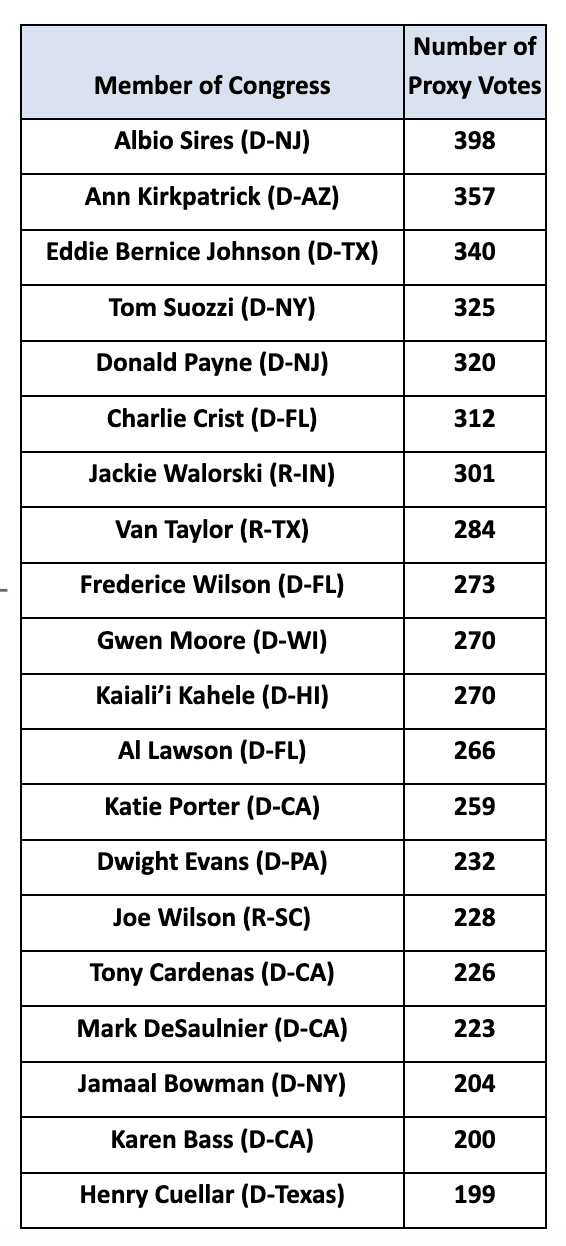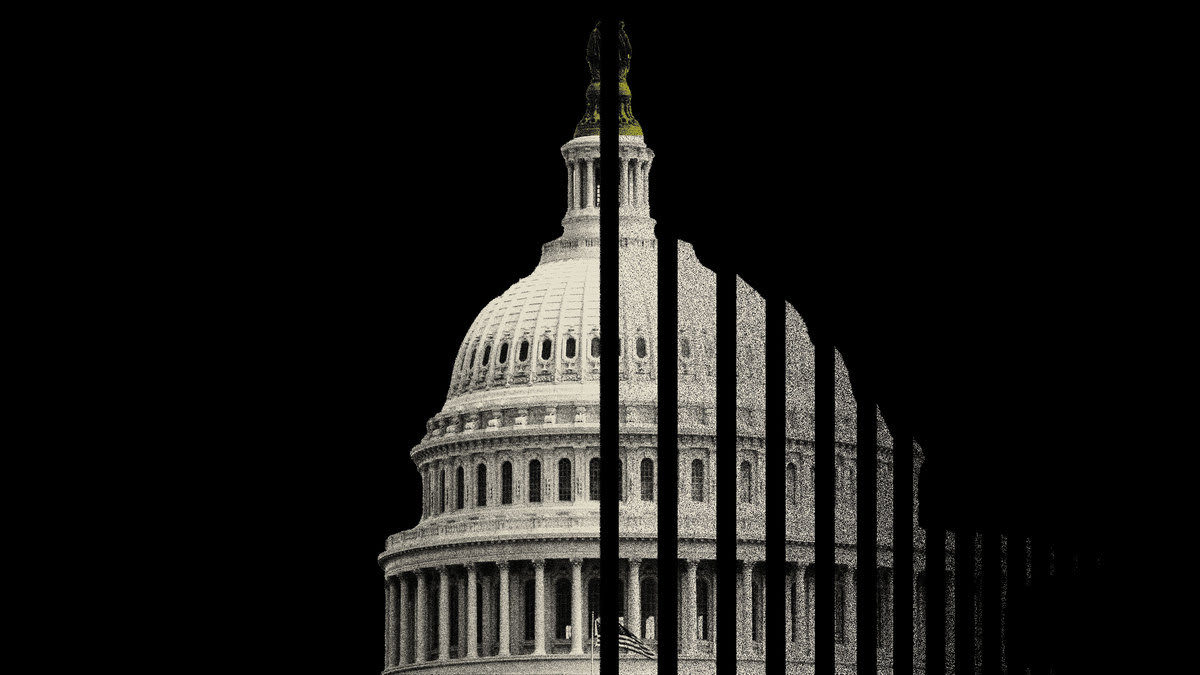When the U.S. House moved to allow lawmakers to vote remotely in May 2020, it was an important step toward preserving the functioning of government during a dangerous and uncertain pandemic.
More than two years later, the country has largely returned to a pre-COVID normal. Capitol Hill itself has even reopened its doors to visitors. And yet, remote voting remains in full effect—with lawmakers using the privilege more than ever.
A comprehensive review of voting data this year in the U.S. House of Representatives, conducted by The Daily Beast, shows that the vast majority of lawmakers have voted remotely at least once.
Since January, 370 members of Congress, roughly 83 percent of the chamber, have cast a remote vote. Combined, those members have voted remotely 23,154 times—greatly surpassing the 17,263 remote votes that were cast in 2021.
A sizable minority of the House has voted remotely on a regular basis. Seventy-seven lawmakers—overwhelmingly Democrats—have voted remotely on 100 or more of the year’s 420 recorded roll call votes. That means roughly one in every six lawmakers has not been present in the U.S. Capitol for at least 25 percent of the roll call votes taken in the House this year.
Among a small handful of members, remote voting is the rule, not the exception. Rep. Albio Sires (D-NJ), for example, has voted remotely 398 times, or 94 percent of all votes, making him the undisputed champion of remote voting. Together, the 10 lawmakers who have used proxy voting the most have taken advantage of the privilege for a combined 2,353 votes.
The year’s proxy voting numbers are “stark,” said Josh Chafetz, a professor of law at Georgetown University who studies the workings of the U.S. House. “It’s obviously not great for the institution to have so many members not around,” he said

Screenshot
Under the rules, a member may designate a colleague to vote as their proxy if they submit a letter attesting that they are unable to participate in person because of the COVID pandemic. In August, Speaker Nancy Pelosi (D-CA) extended proxy voting privileges through Sept. 26, citing the “ongoing public health emergency.” (The smaller, less rambunctious Senate has voted in person throughout the pandemic.)
While a few of the most frequent absentee voters have legitimate COVID-related reasons to stay clear of Capitol Hill, many do not. Since 2020, members have voted by proxy in order to free up their schedules for everything from hitting the campaign trail and doing interviews to pursuing side hustles in commercial aviation and making unauthorized trips to Afghanistan.
A policy that was originally intended as a way to keep members of Congress working in a pandemic has, ironically, turned into a way for them to avoid showing up in Washington for work.
With a recent Gallup survey finding that more than half of the U.S. workforce is “quiet quitting”—barely meeting the minimum expectations for a job while psychologically detaching from their work—it appears the House may not be immune.
On top of widespread proxy voting, Congress is continuing to make use of other pandemic-era procedures that allow members to stay away from Capitol Hill. Committees are convening in person but members have the option to participate in hearings—and vote on legislation in committee meetings—remotely. Over two years after the pandemic first struck, it remains possible for a lawmaker to meet the most basic obligations of the job without leaving their home.
The pandemic is, of course, by no means over. Members of Congress continue to fall sick with COVID, which can disrupt carefully laid legislative plans in the House and Senate, where the majorities are thin. Still, few expected proxy voting to last as long as it has.
“In general, it’s really bad for the institution,” said Matt Glassman, a senior fellow at Georgetown University’s Government Affairs Institute. Proxy voting, he said, takes members out of the policymaking process.
“If you aren’t there for votes, who the hell wants to do the committee work?” Glassman said. “It’s bad for the output of Congress, and it’s bad for the institution of Congress.”
While members of both parties have gladly voted by proxy, the practice is far more prevalent among Democrats than Republicans.
Of the 77 lawmakers who missed more than 100 votes in person, 61 of them are Democrats. Of the top 10 proxy voters, eight are Democrats. (The top Republican proxy voter was the late Rep. Jackie Walorski of Indiana, who was killed in a car crash in her district last month.)
Minority Leader Kevin McCarthy (R-CA), who proudly boasts he has never voted by proxy, has long tried to exploit Democratic use of the process for his party’s political gain. In May 2020, McCarthy quickly initiated a lawsuit challenging the constitutionality of proxy voting. It remained a GOP talking point until January 2022, when the Supreme Court declined to take it up.
As the GOP works toward recapturing control of the House in this fall’s elections, McCarthy has pointed to proxy voting to argue the Democratic majority isn’t doing its job. “Whatever the initial intent of proxy voting, enough is enough,” McCarthy said, in a recent Rules Committee hearing discussing the practice. “It’s time for this body to lead by example, show up to work as Congress has done since its inception, and end proxy voting once and for all.”
Some Democrats, like Rep. Dean Phillips (D-MN), agree that COVID-era proxy voting has reached its expiration date.
“As a proponent of modernization of the institution, we’d be well served by a discussion about the future use of remote voting, virtual hearings and testimony, and other efficiencies made possible by technology,” Phillips told The Daily Beast. “That said, I believe pandemic-inspired proxy voting should come to an end.”
Members have provided plenty of fodder for critics of proxy voting in the past year. Rep. Kai Kahele (D-HI), for example, has voted remotely roughly 64 percent of the time—the 11th most frequent of any member. An investigation from Honolulu Civil Beat found that, among other things, Kahele was spending time back in Hawaii continuing to work as a commercial airline pilot as colleagues cast his vote in Washington.
In August 2021, during the U.S. withdrawal from Afghanistan, Reps. Seth Moulton (D-MA) and Peter Meijer (R-MI) made an unauthorized trip to the country. Both voted by proxy, citing COVID, when they were in Kabul. Moulton is 43rd on the proxy voting list, having done so 144 times.
Chafetz said it was “almost inevitable” that proxy voting would be abused, given how hard it would be to thoroughly vet every written justification for missing a vote. “Once you’re at that stage,” he said, “you’re basically just accepting that it’s going to get used anytime someone just doesn't want to be in town.”
Even if many in Congress believe proxy voting is no longer necessary or feel it reflects poorly on the institution, few observers believe that rampant remote voting will be a major issue for Democrats in this fall’s elections. In the eyes of leadership, the upside of the practice—ensuring that all 219 Democrats can vote, no matter what—likely outweighs any political risks given that Democrats have such a thin majority to work with.
Although that majority has accomplished a great deal legislatively, proxy voting has made for some strange optics in their happiest moments. When House Democrats passed the so-called Inflation Reduction Act in August—a capstone achievement for the party that came after a year of painstaking negotiation—a third of members voted remotely, making the in-town celebrations far more muted than they might have otherwise been.
While tourists and out-of-town guests are once again crowding the hallways of the Capitol, the routine absence of dozens of House members during each week of legislative business remains palpable.
The corridors are especially quiet on Thursdays and Fridays—usually the last votes of the week—as members leverage proxy privileges to shave a day off the already short congressional work week. The Ripon Society, a center-right think tank, published an analysis in December 2021 finding that absentee voting was more prevalent at the beginning and end of in-session weeks.
The fact that proxy voting has been far more prevalent in 2022 than in 2021 may have to do with two key factors unrelated to COVID: retirements and the election-year campaign trail.
Many of the most prolific proxy voters decided to retire from politics or chose to seek a different office. Six of the top 10 proxy voters will not be returning to Congress next year, like Sires. Reps. Charlie Crist (D-FL) and Tom Suozzi (D-NY) are running, or attempted to run, for governor in their home states while missing hundreds of in-person votes. (After facing criticism for abusing proxy voting while campaigning, Crist actually resigned from Congress two weeks ago.)
Of the 77 lawmakers who voted remotely more than 100 times, a third are either retiring or seeking another office. Proxy voting, said Chafetz, “has given members a way to retire two years early and keep their position.”
While the privilege theoretically could free up members to spend more time in their districts to campaign for re-election, very few of those facing competitive races are making use of the proxy privilege, potentially out of concern for getting attacked over the issue.
There are only two incumbents in battleground races among the top 50 most frequent proxy voters: Reps. Katie Porter (D-CA) and Henry Cuellar (D-TX).
It’s unclear if, or when, Pelosi might finally end proxy voting. A spokesperson for the Speaker did not respond to an inquiry for this story.
A GOP takeover of the House could spell an abrupt end to the practice, but experts like Georgetown’s Glassman doubt whether McCarthy could put this particular genie back in the bottle.
“The challenge is, have too many Republicans become too happy with this?” Glassman asked. The danger with proxy voting—as with other changes that have given members more flexibility and time away from the Capitol building—is that “people would come to like it,” he said.
Many observers see the extended era of proxy voting not as a cause of congressional dysfunction but a symptom of it. In recent decades, the House has transformed from a member-driven body into one where a small circle of powerful leaders, in both parties, increasingly make the biggest decisions.
Rank-and-file members, Chafetz said, are increasingly seen as little more than a vote.
“If they see themselves as a vote, well, OK—then why do they need to do any of the other stuff?” he said. “If they can vote from home, why not?”

